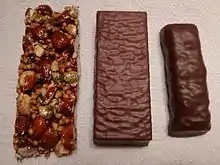Protein bar
Protein bars are convenience food that contain a high proportion of protein relative to carbohydrates and fats. Despite the label focusing on protein, many mass-marketed protein bars contain more added sugar than cookies or a doughnuts.[1]
| Main ingredients | Various protein foods, sugar |
|---|
Dietary purpose
Protein bars are targeted to people who primarily want a convenient source of protein that does not require preparation (unless homemade).[2] There are different kinds of food bars to fill different purposes. Energy bars provide the majority of their food energy (calories) in carbohydrate form. Meal replacement bars are intended to replace the variety of nutrients in a meal. Protein bars are usually lower in carbohydrates than energy bars, lower in vitamins and dietary minerals than meal replacement bars, and significantly higher in protein than either.
Protein bars are mainly marketed to athletes or exercise enthusiasts for muscle building[3][4] or as a wellness-themed convenience food.[1] The global market is growing and expected to reach $2,000,000,000 in annual sales in 2026.[1]
Protein bar niche
In addition to other nutrients, the human body needs protein to build muscles. In the fitness and medical fields, it is generally accepted that protein after exercise helps build the muscles used. Whey protein is one of the most popular protein sources used for athletic performance.[5] Other protein sources include egg albumen protein and casein, which is typically known as the slow digestive component of milk protein.[6] Alternative protein bars may use insect protein as an ingredient. Vegan protein bars contain only plant-based proteins from sources like peas, brown rice, hemp, and soybeans.[7]
Issues
Sugar content
Protein bars may contain high levels of sugar and sometimes are called "candy bars in disguise".[8][9]
Supplementation controversy
There is a disagreement over the amount of protein required for active individuals and athletic performance.[10] Some researches show that protein supplementation is not necessary.[11][12] Athletes generally consume higher levels of protein as compared to the general population for muscular hypertrophy and to reduce lean body mass lost during weight loss.[13]
References
- Blum, Dani (2023-01-12). "Are Protein Bars Actually Good for You?". The New York Times. ISSN 0362-4331. Retrieved 2023-10-11.
- Moss, Michael (2014-01-28). "A Look Inside the Protein Bar". The New York Times. ISSN 0362-4331. Retrieved 2017-08-19.
- Campbell, Bill; Kreider, Richard B.; Ziegenfuss, Tim; La Bounty, Paul; Roberts, Mike; Burke, Darren; Landis, Jamie; Lopez, Hector; Antonio, Jose (2007-09-26). "International Society of Sports Nutrition position stand: protein and exercise". Journal of the International Society of Sports Nutrition. 4: 8. doi:10.1186/1550-2783-4-8. ISSN 1550-2783. PMC 2117006. PMID 17908291.
- Phillips, Stuart M. (July 2004). "Protein requirements and supplementation in strength sports". Nutrition (Burbank, Los Angeles County, Calif.). 20 (7–8): 689–695. doi:10.1016/j.nut.2004.04.009. ISSN 0899-9007. PMID 15212752.
- Kurtis, Frank; Kamal, Patel; Gregory, Lopez; Bill, Willis (2017-07-19). "Whey Protein Research Analysis". Examine.com.
- Kurtis, Frank; Kamal, Patel; Gregory, Lopez; Bill, Willis (2017-04-29). "Casein Protein Research Analysis". Examine.com.
- Rathod, Vaidehi (April 14, 2020). "Be vegan and have your protein too". UTC Scholar.
- "Nutrition Bars: Healthy or Hype?". WebMD. Retrieved 2017-08-19.
- MD, Robert H. Shmerling (2015-12-15). "Are protein bars really just candy bars in disguise? - Harvard Health Blog". Harvard Health Blog. Retrieved 2017-08-19.
- "How much protein do I need every day?". Examine.com. 2013-01-16. Retrieved 2017-08-19.
- Lemon, P. W.; Proctor, D. N. (November 1991). "Protein intake and athletic performance". Sports Medicine. 12 (5): 313–325. doi:10.2165/00007256-199112050-00004. ISSN 0112-1642. PMID 1763249. S2CID 9632893.
- Phillips, Stuart M. (July 2004). "Protein requirements and supplementation in strength sports". Nutrition. 20 (7–8): 689–695. doi:10.1016/j.nut.2004.04.009. ISSN 0899-9007. PMID 15212752.
- Mettler, Samuel; Mitchell, Nigel; Tipton, Kevin D. (February 2010). "Increased protein intake reduces lean body mass loss during weight loss in athletes". Medicine and Science in Sports and Exercise. 42 (2): 326–337. doi:10.1249/MSS.0b013e3181b2ef8e. ISSN 1530-0315. PMID 19927027.
